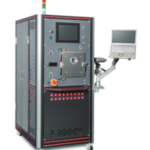
It’s all about sputtering! A simple explanation of the structure of CDs and DVDs.
CDs and DVDs are a familiar part of our lives, whether we listen to music or watch films.
In fact, they are made using sputtering technology.
This article provides a easy explanation of the structure of CDs and DVDs.
To begin with, CDs and DVDs record information by exposing it to light and play it by reading the light reflection.
The iridescent surface of a CD or DVD has three layers.
Reflective layer
A layer of aluminum that reflects laser light. Also called “Land”.
recording layer
Digital signals are recorded. It is convex in shape to the reflective layer.
Also called “Pit”, they do not reflect light.
resin layer
The data is protected by resin coating to smooth the gaps between the reflective surface and the recording layer.
Information is recorded and played back by shining a laser beam on it and using the reflection or non-reflection of the light as a 0 and 1 signal.
Sputtering is then utilized to apply a thin film of aluminum in the reflective layer where light is reflected.
Sputtering creates a uniform thin film of aluminum, which reflects light in a stable manner.
This allows us to record and play back CDs and DVDs reliably.
The technology of sputtering is familiar to us in our daily lives.
We offer a diverse range of sputtering equipment to suit different applications.





